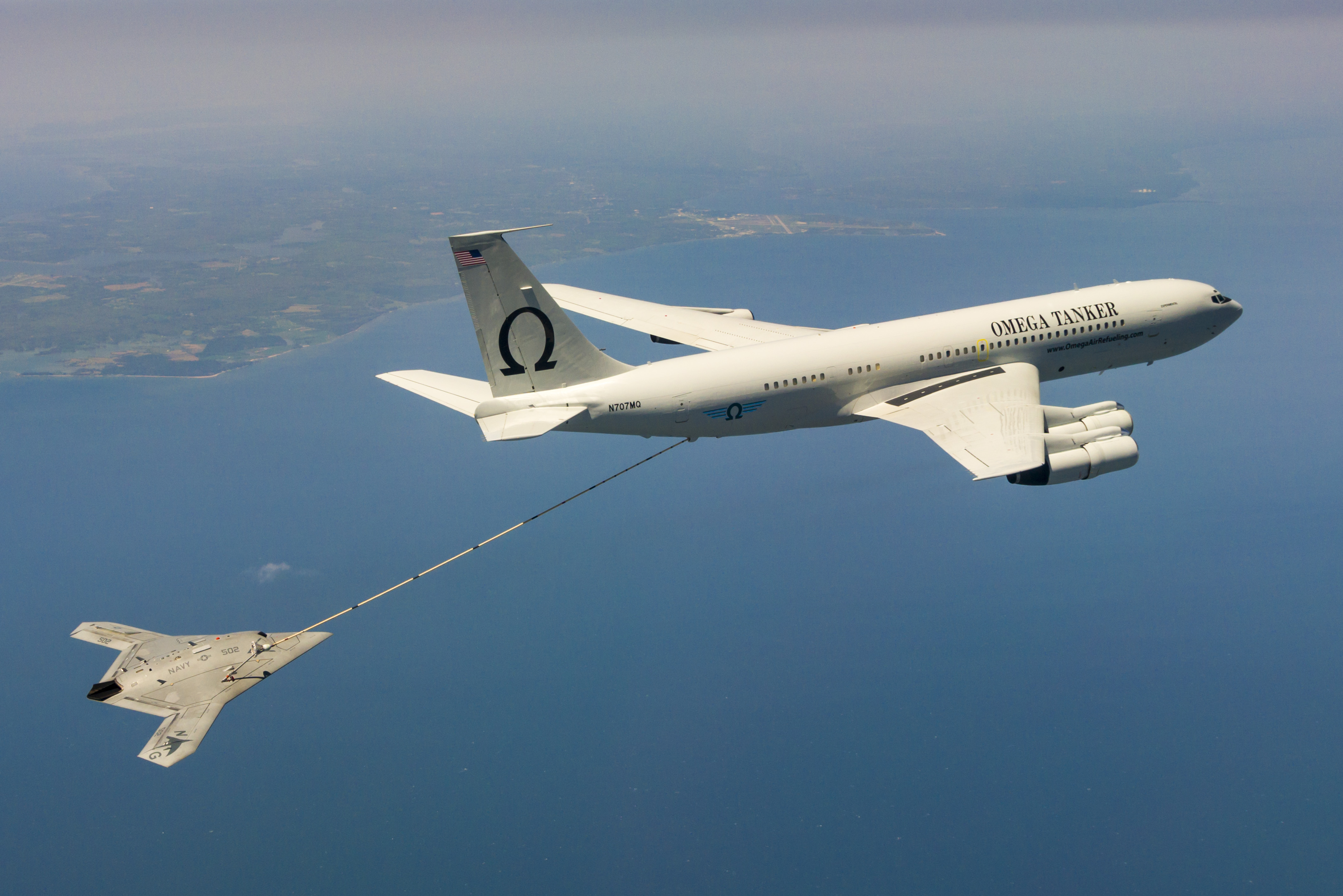
The Navy successfully tested autonomous aerial refueling for the first time with its Northrop Grumman X-47B test unmanned aerial vehicle on Wednesday, marking the end of the Navy’s Unmanned Carrier Air Vehicle demonstrator (UCAS-D) program, Naval Air Systems Command (NAVAIR) told USNI News shortly after the aircraft landed at Naval Air Station Patuxent River, Md.
Cruising over the Chesapeake Bay, the X-47B — call sign Salty Dog 502 — successfully maneuvered behind an contracted Omega Aerial Refueling Services Boeing 707 tanker and took on more than 4,000 pounds of fuel before heading back to Pax River at about 1:15 P.M. EST, NAVAIR spokesperson Jamie Cosgrove told USNI News.
The probe-and-drogue refueling test was successfully completed during the first of two test windows NAVAIR had on Wednesday and days before the availability of the Omega tanker was to expire, USNI News understands.
On April 15, Salty Dog 502 successfully linked with the tanker but didn’t transfer fuel. At least one other test refueling was aborted due to turbulence.
Fueled in flight: X-47B first to complete autonomous aerial refueling http://t.co/Qwb08SmnJK
— NAVAIRNews (@NAVAIRNews) April 22, 2015
The testing was part of a $64 million contract with Northrop Grumman that was issued last year.
“Initial UCAS-D flight testing began in 2012 using a manned Learjet as a surrogate for the X-47B. These successful proof-of-concept flights demonstrated the overall feasibility of the X-47B AAR system and helped refine its navigation, command and control, and infrared sensor processing components,” read a statement from Northrop.
Now with the test completed, Salty Dogs 501 and 502 will be taken out of testing service and remanded to aviation museums or to the Aerospace Maintenance and Regeneration Group (AMARG) “boneyard” at Davis Monthan Air Force Base, Ariz.
Though the aircraft have only used about 20 percent of the flying hours allocated by the Navy, the service has said the cranked kite airframe will likely be too different from what the service expects to eventually employ through its Unmanned Carrier Launched Surveillance and Strike (UCLASS) programs.
“From a X-47 perspective, I don’t see the tie, necessarily,” Capt. B.V. Duarte, program manager of NAVAIR’s PMA-268 that oversees UCAS-D and the Navy’s planned Unmanned Carrier Launched Surveillance and Strike (UCLASS) programs, told USNI News last week.
“Given the differences between the X-47 and the UCLASS and the amount of money it would take to make it a more useful risk reduction platform, [it would be cost prohibitive].”
With its stealthy design, aerial refueling capability and large internal payload, the X-47B is more representative of the Navy’s earlier naval unmanned aerial combat system (N-UCAS) deep strike aircraft, initially outlined in the 2006 Quadrennial Defense Review (QDR).
Since then, the service has modified its goals to create the Unmanned Carrier Launched Surveillance and Strike (UCLASS) program — or RAQ-25 as USNI News understands the program is referred to internally in NAVAIR.
The initial UCLASS goals were to provide an off-cycle surveillance capability for a carrier strike group and provide limited strike capabilities in uncontested airspace that didn’t need an aerial refueling capability.
However an ongoing review of the entire unmanned aerial vehicle (UAV) portfolio — a strategic program review (SPR, pronounced spear) —inside the Office of the Secretary of Defense (OSD) that will inform the final character of UCLASS — is still ongoing.
Some in Congress, like Sen. John McCain (R-Ariz.) and Rep Randy Forbes (R-Va.) — have called for an extension of the UCAS-D testing program. However earlier on Wednesday congressional staffers said more X-47B testing is not currently in the ongoing House Armed Services seapower and projection forces subcommittee.
NAVAIR had scheduled to end the UCAS-D program after Salty Dog 502 successfully landed on USS George H.W. Bush (CVN-77) in 2013 but Navy leadership requested the program be extended to complete the AAR testing.





